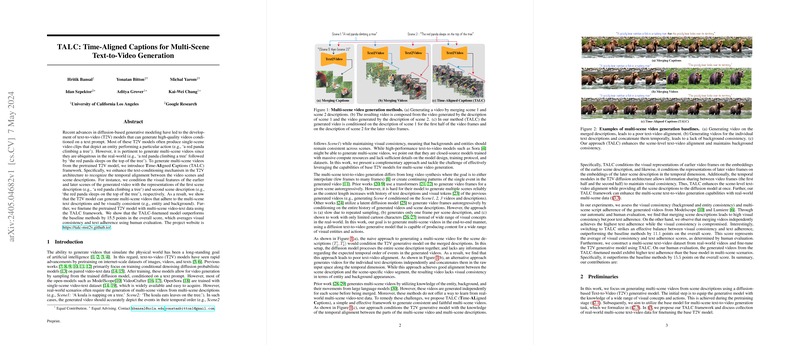Exploring Multi-scene Video Generation with Time-Aligned Captions (TALC)
Introduction to Multi-Scene Video Generation
In the field of text-to-video (T2V) models, recent advances have significantly improved our capability to generate detailed and visually appealing video clips from text prompts. However, these developments have predominantly focused on generating videos depicting single scenes. Real-world narratives, such as those found in movies or detailed instructions, often involve multiple scenes that smoothly transition and adhere to a coherent storyline.
This discussion explores a novel framework fittingly named Time-Aligned Captions (TALC). Unlike traditional models, TALC extends the capabilities of T2V models to not only handle more complex, multi-scene text descriptions but also ensure visual and narrative coherence throughout the video.
Challenges in Multi-Scene Development
Generating multi-scene videos offers a set of unique challenges:
- Temporal Alignment: The video must correctly sequence events as described across different scenes in the text.
- Visual Consistency: Characters and backgrounds must remain consistent throughout scenes unless changes are explicitly described in the text.
- Text Adherence: Each video segment must closely align with its corresponding text, depicting the correct actions and scenarios.
Historically, models have struggled with these aspects, often either merging scenes into a continuous, somewhat jumbled depiction or losing coherence between separate scene-specific video clips.
TALC Framework Overview
TALC addresses these challenges by modifying the text-conditioning mechanisms within T2V architecture. It carefully aligns the text representation directly with corresponding segments of the video, allowing for distinctive scene transitions while maintaining overall coherence. Let's break it down:
- Scene-Specific Conditioning: In TALC, video frames are conditioned on the embeddings of their specific scene descriptions, effectively partitioning the generative process per scene within a single coherent video output.
- Enhanced Consistency: By integrating text descriptors through cross-attention mechanisms in a manner that respects scene boundaries, TALC helps maintain both the narrative and visual consistency across the multi-scene video.
Practical Implications and Theoretical Advancements
The introduction of TALC is a significant step forward because it allows for more complex applications of T2V technologies, including but not limited to educational content, detailed storytelling, and dynamic instruction videos.
From a theoretical standpoint, TALC enriches our understanding of multi-modal AI interactions, demonstrating a successful approach to align multi-scene narratives with visual data. This not only enhances the text-video alignment but also provides a scaffold that might be applicable in other contexts such as video summarization and more complex narrative constructions.
Speculating on Future Developments
Looking ahead, TALC opens several pathways for future research and development:
- Integration with Larger Models: Applying TALC to more powerful T2V models could yield even more impressive results, potentially creating videos with cinematic quality from complex scripts.
- Dataset Enrichment: As TALC relies on well-annotated, scene-detailed datasets, there's a potential need for dataset development that specifically caters to multi-scene video generation.
- Real-time Applications: Future iterations might focus on reducing computational demands, allowing TALC to be used in real-time applications, enhancing tools in video editing, virtual reality, and interactive media.
Conclusion
In essence, the Time-Aligned Captions framework significantly advances multi-scene video generation technology. By enabling more accurate and coherent video production from elaborate multi-scene texts, TALC not only enhances the current capabilities of T2V models but sets the stage for further exciting developments in the field of generative modeling.
